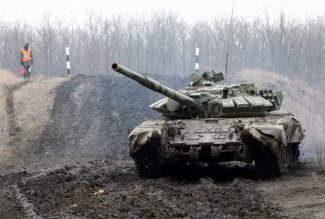Russian pressure on Ukraine: military and political dimensions

Since the end of March, the government in Kyiv has been warning that Russia is transferring additional armed forces to the Ukrainian border, which, as it says, may mean Russia is making preparations for a new phase of military operations. These moves have been accompanied by the largest number of armed incidents and casualties incurred in recent months on the so-called line of separation in the Donbas between Ukrainian forces and the Moscow-controlled separatists. The West has expressed growing concern about the situation in the region, expressed as follows: the first telephone conversation between Presidents Volodymyr Zelensky and Joe Biden; a conversation between Biden and Putin and their decision on a meeting at which Ukraine would be discussed; an extraordinary visit to Kyiv by the Polish foreign minister Zbigniew Rau; a joint Franco-German statement; and declarations by NATO and other countries in which unambiguous statements were made in support of the territorial integrity of Ukraine, as was criticism of Russia for its provocations along the borders. This shows that in the international perspective, the rise in tensions in eastern Ukraine has been recognised as the steepest in recent months.
The military dimension
- Over the past two weeks, videos and photos have appeared online showing the deployment of extra Russian army units to the Russian regions bordering Ukraine and to annexed Crimea. Although most of the recorded movement concerns troops which have been permanently deployed near these borders, it should be assumed that they also include sub-units from other regions of the country (see Appendix).
- The ostentatiousness of the Russian actions is noteworthy: in the transfers of troops by rail which have been observed, the basic weapons have not normally been covered with tarpaulins. At the same time, this confirms that most of the equipment transported belongs to the units deployed in border regions (for example, the units from the Central Military District do not include BMP-3 infantry fighting vehicles); this proves that the Russian Armed Forces’ activity here is demonstrative in nature. Only in one case (transport of various types of tanks, including some which have been withdrawn from service in the Russian army) should it be assumed that the so-called separatists in the occupied part of Donbas are the intended recipients.
- The transfer of military units from other regions of Russia to the vicinity of the border with Ukraine – even if the maximum figures reported in the media are to be considered accurate – does not constitute a significant operational reinforcement of the Russian Armed Forces’ local potential. In the regions bordering Ukraine, in occupied Crimea and in part of the Donbas, its army (together with the forces of the so-called separatists) numbers about 150,000 soldiers. Thus, the accumulation of forces at the border makes them capable of limited involvement at any time, depending on what political decision the Kremlin takes, without the need for any additional preparation or to draw upon units from other regions.
The political dimension
- The Russian side has not denied the increase in its military activity in the region of the Ukrainian border. However, they are trying to present it as a response to the alleged escalation of the conflict by Kyiv (which is untrue); as a measure to deter the Ukrainian offensive in the Donbas which is allegedly being prepared; and to protect the Russian-speaking population (including Russian citizens) in the occupied parts of the region. This issue has come to predominate in the statements made by Russian officials and the reports by the Kremlin’s media.
- One factor mobilising the Russian side is the actions Ukraine has undertaken in recent months to demonstrate the increased assertiveness of the Kyiv government towards the Russian Federation, including initiatives to make the implementation of the Minsk agreements more favourable to Ukraine and, in particular, sanctions affecting Russia’s interests and its tools of political influence in Ukraine (against Viktor Medvedchuk and the TV stations under his control).
- Moscow’s political intention is to create the impression that the conflict in the Donbas could escalate to an unspecified degree, leading to open war between Russia and Ukraine. The former hopes that, given the unwillingness of the West (especially Western Europe) to further deepen the crisis in their relations, such a threat will force the most important Western countries (the US, and especially Germany and France) to increase their efforts to find a diplomatic resolution to the conflict. The political price to pay would be concessions from Ukraine (such as accepting the Russian version of implementing the Minsk agreements) and possibly the West (for example not introducing any new sanctions, or easing the existing ones) to ‘save the peace’. At the same time, however, Russia's immediate priority in the next few months will be to complete the construction of the Nord Stream 2 pipeline, and seriously escalating the conflict would seriously prejudice that.
- If the above-mentioned political goal is not achieved (the Ukrainian and Western sides will not be willing to offer such serious negotiations and concessions), Russia will most likely decide to lend credence to its threats by undertaking further aggressive political and/or military actions in the Donbas. A limited escalation of military operations may be involved, perhaps as a result of a provocation for which the Ukrainian side will be blamed. Such an escalation may be triggered by the ‘separatists’ on their own (albeit in the presence of Russian troops, who will then be portrayed as a factor deterring the Ukrainian side from defending itself more actively).
- An alternative or extension to such a scenario could be radical political moves on Moscow’s part, such as recognising the independence of the Donbas puppet ‘republics’ (the so-called Donetsk and Lugansk People's Republics), as was done with Abkhazia and South Ossetia in 2008 – or even their formal annexation (as in the case of Crimea in 2014). On the one hand, such actions could bring the Kremlin a temporary political benefit: it could serve as a ‘patriotic boost’ to most of Russian society before the parliamentary elections in September 2021, and (symbolically) before the 30th anniversary of the USSR’s collapse in December 2021. On the other hand, however, such a move could entail serious political costs: we should then expect more serious Western sanctions against Russia and the loss of any hope of a ‘normalisation’ of relations with the West on Moscow’s terms. For these reasons, the above scenarios should be treated as sub-optimal from the point of view of the Russian Federation, and thus not preferred by Moscow. For the same reasons, a massive invasion of Ukraine with the occupation of all or a large part of its territory is even less likely.
ANNEX
Reports of an increased Russian presence on Ukraine’s borders
- According to the available information, a tank battalion (or a tactical battalion group based on it) from the 74th Mechanised Brigade (Yurga in Kemerovo oblast) and the Iskander missile systems battery from the 119th Missile Brigade (Yelansky in the Sverdlovsk oblast) may have been deployed near Voronezh. These tactical groups are part of the 41st Combined Arms Army of the Central Military District.
- The Ministry of Defence of the Russian Federation has confirmed the deployment to the Black Sea of a total of 12 units of the Caspian Flotilla team (artillery and landing boats as well as tugs, which are the largest units of the team). On 11 April, a team traveling by inland waterways entered the Don.
- The deployment of the first elements of the 56th Air Assault Brigade (from Kamyshin in the Volgograd oblast, Southern Military District) in the last few weeks should be seen as the implementation of previous plans to develop an assault regiment in Crimea (repeatedly announced since 2017).
- There is no direct confirmation of the deployment of any more of the sub-units and entire major tactical military formations which have been mentioned above or other formations at this level to the regions bordering Ukraine. The latter include the 35th Mechanised Brigade (Aleysk in Altai krai), the 120th Artillery Brigade (Yurga) and the 6th Tank Regiment of the 90th Armoured Division (Chebarkul in Chelyabinsk oblast) from the Central Military District; the 136th Mechanised Brigade (Buinatsk in Dagestan) from the Southern Military District, as well as the 104th Air Assault Regiment of the 76th Air Assault Division (Pskov) from the Western Military District.
- When assessing the redeployment of sub-units from the Central Military District to the regions bordering with Ukraine, we should recall that the direct support (second operational line) for units deployed in this direction would primarily be the 1st Panzer Army of the Western Military District and the 58th Combined Arms Army of the Southern Military District. As of yet no information has emerged – at least in the media – about the movement of units from any of these armies towards Ukraine.





